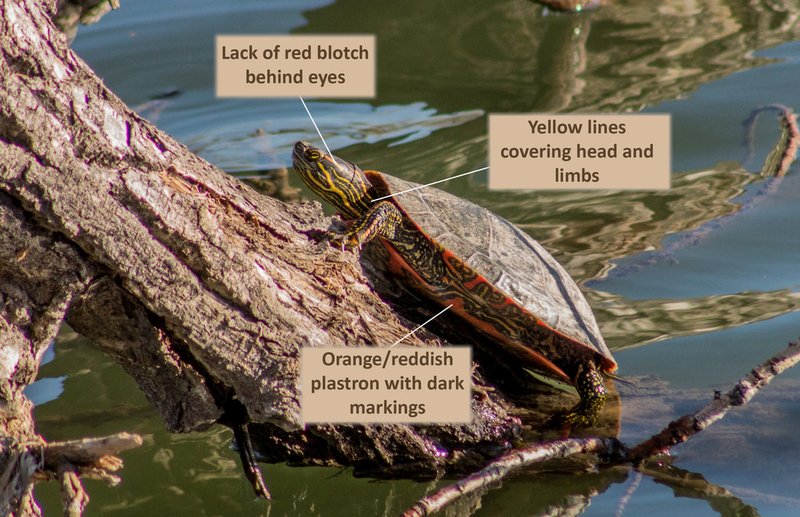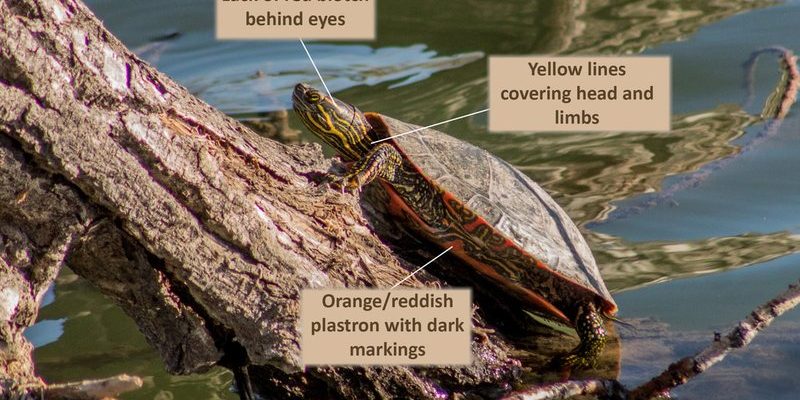
Imagine trying to find a specific book in a library. You might start by looking at the cover and colors—similar to how you’d identify a painted turtle. With its bright patterns and charming demeanor, this turtle stands out among its peers. So, grab your binoculars, and let’s dive into the colorful world of painted turtles!
Overview of Painted Turtles
Painted turtles belong to the *Chrysemys* genus and can be found across North America. They thrive in freshwater environments, preferring lakes, ponds, and marshes. You’ll often find them basking on sunny rocks or logs. Their vibrant colors—black shells adorned with yellow and red stripes—truly set them apart.
These turtles are medium-sized, typically measuring between 4 to 10 inches in length. The upper shell, called the carapace, is usually dark green or black with striking patterns. The underbelly, or plastron, is often a bright yellow. This contrast makes them easily recognizable.
One interesting fact? Painted turtles are gentle and calm creatures. Their playful nature often leads them to swim in small groups, basking together in the sun. Honestly, isn’t that adorable?
Physical Characteristics
To identify a painted turtle, start by observing its physical features. The most noticeable characteristic is its carapace. It’s often smooth and can be either olive green or black, with an array of bright stripes or spots. You might notice the coloration can change with age, becoming darker as the turtle matures.
Next, take a look at its head. Painted turtles have a distinctive head with yellow stripes running down the neck and a small, pointed snout. These stripes can sometimes blend into spots, making the turtle even more unique.
Don’t forget about the legs and tail. Their legs have webbed feet, perfect for swimming, and their tails are relatively long compared to their bodies. Here’s the thing: if you see a turtle with colorful markings and a smooth shell, it’s likely a painted turtle!
Habitat and Behavior
Painted turtles love to hang out in warm environments with plenty of sunlight. You’ll typically find them in shallow waters with soft bottoms, like ponds or slow-flowing rivers. They enjoy basking on sunny logs, soaking in warmth to regulate their body temperature.
In terms of behavior, painted turtles are quite social. They often bask together on logs or rocks, and you may even notice them slipping into the water if they feel threatened. They’re surprisingly agile swimmers, using their strong legs to propel themselves gracefully through the water.
If you’re looking to spot one, early morning or late afternoon is the best time. They’re more active during these hours, making it easier to observe them basking or swimming.
Recognizing Subspecies
Did you know there are four subspecies of painted turtles? It’s true! Each has its own unique features that can help with identification.
1. Eastern Painted Turtle (*Chrysemys picta picta*): Common in the eastern U.S., this subspecies has a vivid yellow plastron and striking red stripes on its carapace.
2. Western Painted Turtle (*Chrysemys picta bellii*): Found in the western U.S. and Canada, these turtles have a darker carapace and less vivid markings.
3. Southern Painted Turtle (*Chrysemys picta dorsalis*): This one is often larger than the others and has a more prominent yellow stripe on its head.
4. Northern Painted Turtle (*Chrysemys picta circumdata*): It has a flatter shell and a more muted color palette, making it less vibrant than its southern counterpart.
Recognizing these differences can enhance your turtle-spotting experience, adding an exciting layer to your nature walks.
Common Habitats to Spot Painted Turtles
If you want to see painted turtles in their natural habitat, certain locations are more promising than others. Look for:
- Ponds: These are often shallow and warm, perfect for painted turtles.
- Marshes: Rich in vegetation, marshes provide food and shelter.
- Lakes: Calm, shallow areas near the shore are ideal spots for basking.
- Slow-moving rivers: Turtles often bask on rocks along the banks.
When approaching these areas, remember to be quiet and patient. Turtles can be skittish, so give them space to bask undisturbed. With a bit of luck, you’ll catch a glimpse of these stunning creatures!
What to Avoid While Observing
To ensure you have a positive experience while observing painted turtles, keep a few things in mind. First, avoid making loud noises or sudden movements. Turtles are sensitive and can quickly retreat into the water.
Also, try not to disturb their habitats. This means keeping a safe distance and not trying to touch or handle the turtles. They’re wild animals, after all, and it’s best to admire them from afar.
Lastly, avoid feeding turtles. It might seem harmless, but it can disrupt their natural foraging habits and lead to health issues. It’s best to let them thrive in their natural diet.
Why Identifying Painted Turtles Matters
Identifying painted turtles is more than just a fun hobby; it helps us understand and appreciate our local ecosystems. By recognizing these turtles, you help contribute to their conservation. Many painted turtle populations are declining due to habitat loss and pollution.
When you learn to identify them, you become more aware of their needs and challenges. You’re not just a spectator in nature; you’re an active participant in its preservation. Understanding how to spot painted turtles also encourages others to take an interest in local wildlife, promoting a greater sense of stewardship for our environment.
In conclusion, identifying a painted turtle in the wild combines a blend of observation, knowledge, and appreciation for nature. With its vibrant colors and playful behavior, the painted turtle is a true gem of our freshwater ecosystems. So, next time you’re near a pond or river, keep an eye out for these charming creatures; you may just find yourself mesmerized by their beauty!

